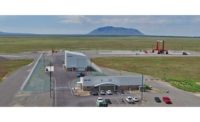Energy Dept. Begins Bore-Hole Testing to Find Potential Storage for Low-Level Waste

Spent nuclear fuel often is stored in temporary facilities, such as the cooling ponds (above) at the Brunswick Nuclear Power Plant, located in Southport, N.C.
PHOTO COURTESY OF NUCLEAR REGULATORY COMMISSION
A scheduled drilling effort to construct a test borehole in the deep shale formations of North Dakota is one of the first moves in the U.S. Dept. of Energy’s formal effort to develop new nuclear storage options for low-level radioactive waste fuel from nuclear powerplants, now often housed on-site in temporary facilities, such as cooling ponds and aboveground concrete casks.
“This is an important first step to increasing our scientific understanding of the potential uses for crystalline rock formations, including the feasibility of boreholes as an option for long-term nuclear waste disposal,” said DOE Secretary Ernest Moniz in a January statement.
The Nuclear Energy Institute says U.S. officials are scrambling to look for alternatives to the beleaguered Yucca Mountain, a Nevada mined repository site, 100 miles northwest of Las Vegas, that has been mothballed by the Obama administration after years of fierce local political opposition to the dangers of nuclear waste.
“There is a permanent solution for spent fuel from powerplants that we spent $10 billion building for the past 20 years,” says Forest Remick, a consultant for NEI and former commissioner of the Nuclear Regulatory Commission. “Yucca Mountain is safe. There are no technical problems there, only political. Sen. Harry Reid [D-Nev.] is the one who fought it—he’s friends with Obama.”
The North Dakota borehole test is part of a formal initiative, announced by DOE in December, aimed at establishing a permanent disposal site for spent nuclear fuel. The program seeks at least one flagship site with community consent, DOE says.
Because of a backlash in Nevada, DOE has developed a “consent-based” siting initiative so that local communities are involved from the very beginning.
Nuclear storage is a major priority for DOE, said Battelle Memorial Institute, which is leading a team near Rugby, N.D. Rod Osborne, manager of Battelle’s energy business line, told ENR that determining the feasibility of deep-borehole disposal is the goal of the estimated $35-million, five-year project on a 20-acre plot of state-owned land. “DOE has to find new solutions for nuclear storage,” Osborne says. “This is one of the ideas.”
Concept designs leverage depth for safety, Osborne says. Even if a nuclear-waste canister leaked, the borehole system, isolated at 16,000 ft, is designed so that leachate would never reach the water table, thousands of feet above.
Battelle’s experience in the oil-and-gas sector translated well to borehole construction, but research at the site will generate new data on the hydrogeological, geochemical and geomechanical characteristics of the “host rock.”
“We will mostly be collecting data on how fluid flows through various rock formations and how cuttings affect the mechanical properties, interconnectedness of the different layers and the permeability of the rock,” Osborne says. “It’s an opportunity to generate real, honest-to-goodness data that, right now, doesn’t exist.”
Remick says DOE has been under pressure from powerplants to remove spent fuel from temporary storage facilities. “DOE was supposed to pick those up, and several utilities are not happy that they are having to bear the expenses of storing the spent fuel,” he observes.
Since 1998, DOE has not met its contractual obligation to accept used nuclear fuel. More than 68,000 metric tons of used nuclear fuel are stored at 72 commercial powerplants around the country, with some 2,000 metric tons added to that amount every year, DOE says.
Boreholes could be built and filled more quickly and cheaply than repositories such as Yucca Mountain. DOE says a permanent alternative will not be available until 2048; but these deep boreholes can be constructed in five years, noted Battelle. In addition, because of new techniques to minimize the volume of spent nuclear fuel, boreholes could be much more effective in terms of the amount of material they can store, Osborne says.
DOE scientists have identified many regions in the U.S. with large, geologically stable rock formations similar to the North Dakota location, Osborne said.





